As the weather gets warmer and trees bloom, many birdwatchers ask: “Should I keep my bird feeders out in summer?” The answer depends on where you live, the birds you see, and what you like as a bird lover.
In some places, birds might need extra food from feeders during hot or dry times when natural food is hard to find. But others think birds should find their own food in summer, when there are plenty of insects and native plants.
Key Takeaways
- Leaving feeders up all year can help birds, but you must keep the food clean and fresh.
- Take down suet feeders in hot weather to stop them from spoiling and getting birds dirty.
- Birds like native plants that attract insects during the summer nesting season.
- Hummingbirds and goldfinches might still need extra food in summer.
- Experts have different views on when to stop feeding birds, so think about your local weather and bird types.
Introduction to Summer Bird Feeding
Summer is a great time to see colorful birds and their lively actions in our backyards. Some wonder if we should keep summer bird feeding. But experts say giving avian nutrition can help birds, especially when they’re breeding.
The Debate: To Feed or Not to Feed Birds in Summer
People have different views on year-round bird feeding. Some think birds should find their own food in summer. But, many groups support continued bird feeding in summer. They say it helps birds with their nests and young birds.
Benefits of Continued Bird Feeding During Warm Months
Keeping backyard bird feeders open in summer has many benefits. Birds like hummingbirds, orioles, and grosbeaks come to feeders in summer. This lets you see their bright colors. Bird feeding also helps baby birds grow strong during the breeding season.
“There is no evidence that the presence or absence of feeders alters the migration behavior of backyard bird species during the summer.”
By offering supplemental bird feeding, we help local bird populations stay healthy and happy.
Seasonal Changes in Bird Behavior and Diets
When the weather gets warmer and it’s time to breed, birds change their ways. They start focusing on making nests and feeding their babies. This means they eat differently too.
Breeding Season: Nesting Activities and Feeding Habits
Birds look for the perfect spot to nest when it’s breeding time. They build nests and care for their babies. They eat more insects because their babies need lots of protein.
Even though birds might eat less during this time, it’s good to keep feeding them. Offer seeds and suet all year. These foods help them when finding food is hard or not easy.
Keeping feeders out helps young birds learn to find food. This skill is important for when they live on their own.
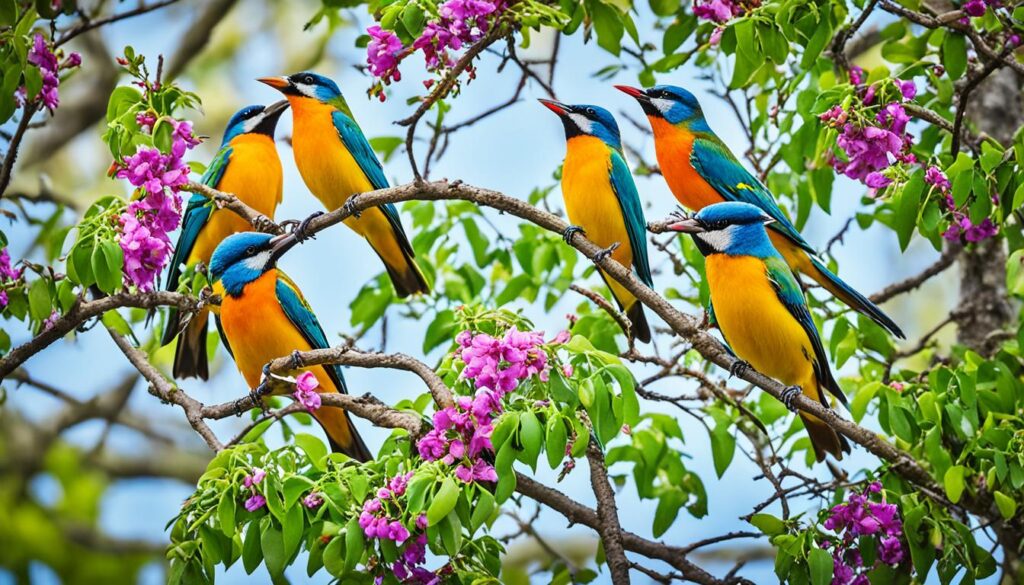
“During the breeding season, many birds focus on eating insects to feed their young, so feeding is less necessary. It is also important for young birds to learn how to find naturally occurring foods.”
As their babies grow, birds might eat differently. Knowing about avian diet changes and bird nesting activities helps us feed them right all year.
Factors to Consider When Feeding Birds in Summer
When summer comes, bird lovers need to think about how to feed their birds right. Keeping up with summer bird feeding and bird feeder maintenance is key. It helps keep backyard birds healthy and avoids wildlife conflicts or nuisance behavior.
Preventing Food Spoilage and Maintaining Feeder Hygiene
Summer means being careful about preventing food spoilage. Suet can get soft and bad in the heat, so take down suet feeders. Bird seed can also go bad quickly. So, change out your food often or don’t fill feeders too much to stop it from getting dirty.
Keeping feeders clean is also key in summer. Wash feeders every two weeks to keep them clean. This keeps birds healthy and stops mold from growing. Mold can make a deadly toxin for birds.
Addressing Wildlife Conflicts and Nuisance Behavior
If you have wildlife conflicts, like bears, take down your feeders in summer. Keeping bird feed dry and using secure feeders can also stop nuisance behavior from squirrels or other critters.
By thinking about these summer bird feeding tips, you can make sure your backyard birds have a safe, healthy food source. This way, you avoid any problems too.
Hummingbird Feeders: A Summer Delight
Summer is the best time to watch hummingbirds at your feeders. These tiny birds fly fast and eat a lot, needing almost half their weight in nectar daily. By using hummingbird feeders, you help them get the food they need, especially when they’re raising their young.
Keeping hummingbird feeders clean is important in the summer. In temperatures between 61-70ºF, clean and refill feeders every 4-5 days. As it gets hotter, you’ll need to check them more often. For example, in 71-80ºF, check them every 3 days, and daily in 81-85ºF. If it’s over 86ºF, clean and refill them every day to keep the nectar fresh and safe for the birds.
“The recommended sugar solution for feeders is a ratio of 4 parts water to one part white cane sugar. Avoid using colored, pre-mixed solutions, as natural nectar is colorless.”
Using feeders like the HummZinger makes cleaning easy. They’re designed for quick and effective cleaning. This way, you can make sure the hummingbirds always have food in the summer.
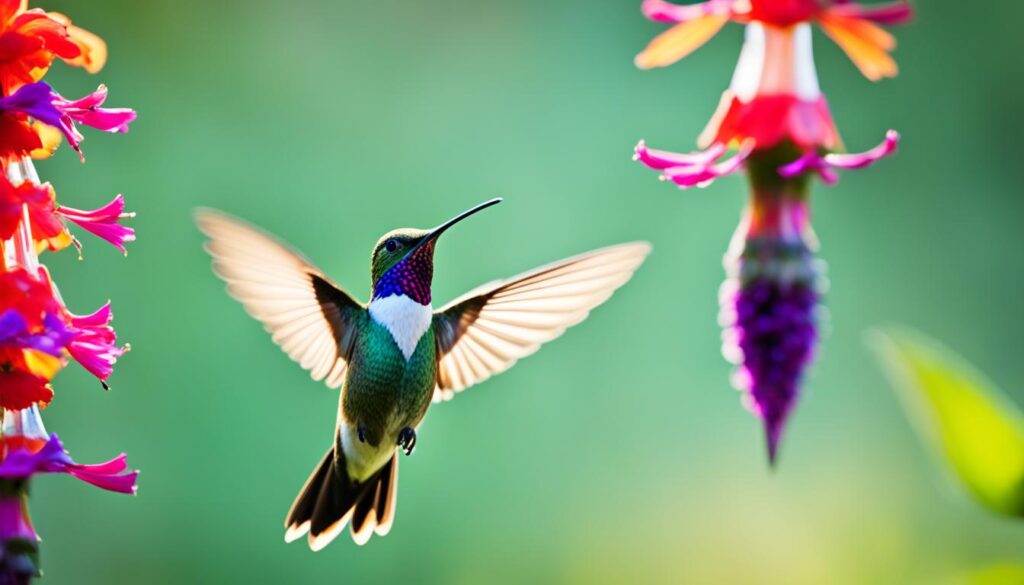
Hummingbird feeders are great for attracting these birds, but they shouldn’t replace their natural food. Native plants that offer nectar and insects are key to their diet. Adding both feeders and these plants to your garden makes a welcoming home for hummingbirds.
Goldfinches and Nyjer Seed: A Summer Favorite
When summer comes, the goldfinch becomes a standout bird. These birds are bright and fun to watch. Feeding them nyjer seed can bring them to your yard all summer.
Goldfinches live in many parts of North America. They eat mostly seeds, especially nyjer, unlike many other birds. This makes them perfect for summer bird feeding.
Keeping nyjer seed in your feeders will attract these finches. They nest later than many birds, so feeding them in summer supports their breeding. It’s also fun to watch their lively behavior.
Watching goldfinches at your feeders is enjoyable. They also spread seeds from various plants, helping your garden’s biodiversity.
If you love birds or are new to summer bird feeding, try using nyjer seed. It’s a great way to welcome these colorful and lively finches to your yard.
When to stop feeding birds in summer?
Expert Recommendations from Wildlife Organizations
Experts say you shouldn’t stop feeding birds in spring and summer. The U.S. Fish and Wildlife Service suggests keeping feeders full of seeds and suet all year. The Cornell Lab of Ornithology agrees, saying to “keep the restaurant open year-round” with different food types.
Wildlife groups give several reasons to keep feeding birds in summer:
- Insects and berries might be hard to find for birds during hot, dry times.
- Supplemental food helps birds stay energetic and keep up with nesting.
- Feeding all year brings more bird species to your yard, making your backyard a lively place.
Make sure your feeders are clean and the food is fresh to avoid health problems for the birds.
“Keep the restaurant open year-round” – Cornell Lab of Ornithology
Following expert advice lets you help birds in your area all summer long.
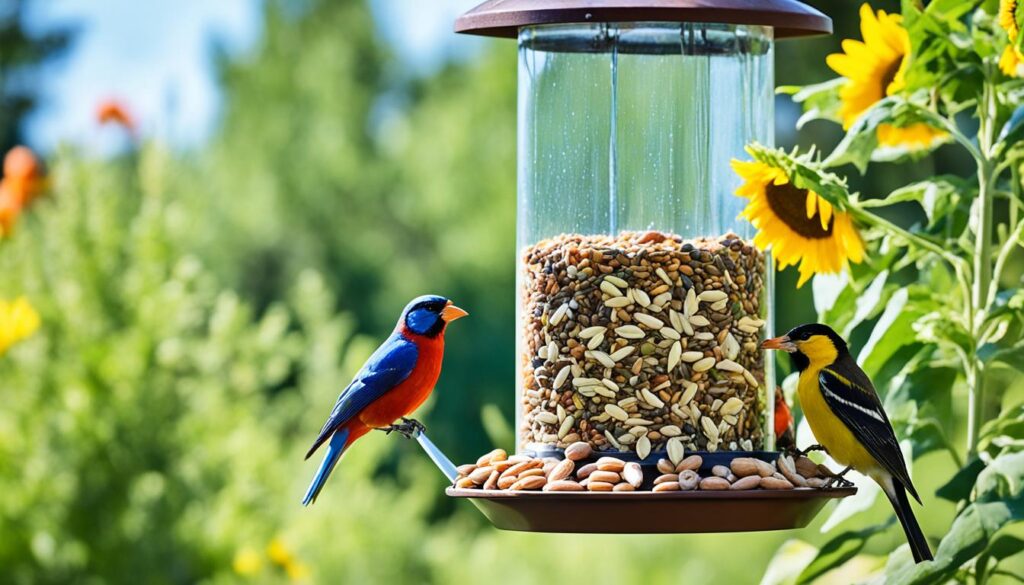
Feeder Placement for Summer Bird Feeding
As summer comes, think about where you place your bird feeders. Look for shaded areas for your bird feeders. Birds like to stay cool, so they might not come to feeders in the hot sun.
Providing Shade and Water Sources
Shade is important, but so is water. Set up a birdbath or a slow drip from a spigot for birds to cool off. Putting your feeders in the shade and adding water makes your backyard a bird-friendly spot all summer.
“Placing bird feeders in shady spots in hot weather prevents mold formation in feeders.”
By placing your feeders right, you make your backyard a great place for birds. Shade and water are crucial for keeping birds coming back. They make your yard a haven in the heat.
Attracting Different Bird Species in Summer
When summer comes, your backyard feeders might draw in many summer bird species. Birds like hummingbirds, woodpeckers, bluebirds, and others can brighten up your backyard bird diversity. To welcome these birds, offer different foods and make your yard a friendly place for them.
Offering fresh fruit like oranges and grapes can lure birds like orioles, robins, catbirds, and mockingbirds. Also, give them grape jelly in small amounts. This is a tasty snack without overfeeding them.
On hot summer days, use no-melt suet cakes to keep the fat fresh. Live mealworms can be a great treat for bluebirds, but give them just a little. This keeps them from eating too much of it.
- Keep a birdbath fresh with a Water Wiggler to make the water appealing to many birds.
- Use hummingbird feeders with a 4:1 water to sugar mix, and skip the red dye.
- Thistle seeds are perfect for finches, American goldfinches, indigo buntings, and lazuli buntings all year round.
To keep your backyard bird diversity healthy, use baffles to keep squirrels and raccoons away from the feeders. This keeps the food safe for the birds. With a variety of foods and feeders, you can attract more summer bird species to your yard.
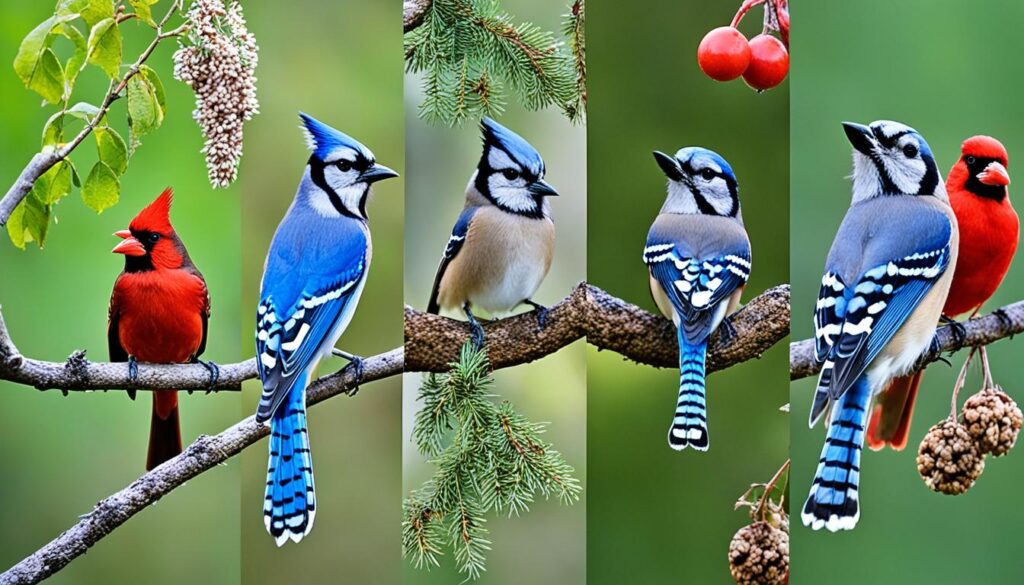
Each bird likes different foods, so try out various options to see what your local seasonal bird populations prefer. With some effort, you can turn your backyard into a summer haven for bird watching.
Preventing Window Collisions During Summer
As summer comes, birds become more active, raising the risk of window collisions. These bird window strikes are a big threat to our feathered friends, especially in summer. Luckily, we can use window strike prevention methods to protect them.
Windows that reflect the sky and plants can trick birds, making them think there’s nothing in their way. To stop this, keep bird feeders more than 30 feet from windows or closer than 3 feet. This helps birds see the window as a barrier.
- Keeping feeders in this “danger zone” can cut down on window collisions.
- Changing how your windows look, like with streamers or window strike prevention decals, also helps birds see the glass.
Another way to prevent window strikes is to make your home less bright. Bright lights can confuse birds, especially at night or in fog. Turning off some lights can cut down on collisions by 6-11 times.
“Immediate help from a wildlife rehabilitation facility significantly increases a bird’s chance of recovery after a window strike.”
If a bird hits your window, act fast. Call a local wildlife rehab center for help. They know how to care for injured birds.
Using these window strike prevention tips can save our summer bird window strikes. We can make a safer place for birds to live. Let’s work together to protect them.
Summer Bird Feeding and Migration Patterns
As summer comes, bird lovers might wonder if they should keep feeding their birds. Experts usually say to feed birds all year, but it’s important to know how summer feeding affects their migration. Studies show that extra food in summer can mess with their natural eating habits and migration.
Birds get most of their food from nature, not feeders. But, some birds can gain a lot of weight before they migrate. This extra fat is their fuel for the long trip. Weather, climate, and predators can change when birds migrate, but the main reason is the changing sunlight.
To help migratory birds in summer, fill feeders for 2-3 weeks after the last bird visit. Also, don’t cut down trees and shrubs in late summer or fall. This makes a safe place for birds to stop. A yard with water, shelter, and the right colors can also draw in migratory birds.
Migratory birds change their stomachs for the trip. Their bellies get bigger and cells store energy. They need foods high in protein and low in fat for their long flights. Feeding them suet with peanuts, sunflower seeds, and beef suet is very helpful.
“Birds start their migration when food sources decrease with changing seasons, and they migrate to areas with better food availability, typically flying toward the equator from breeding grounds in the north.”
Understanding how summer feeding affects bird migration helps us help our feathered friends. By feeding them smartly, we can keep our yards safe for both local and migratory birds.
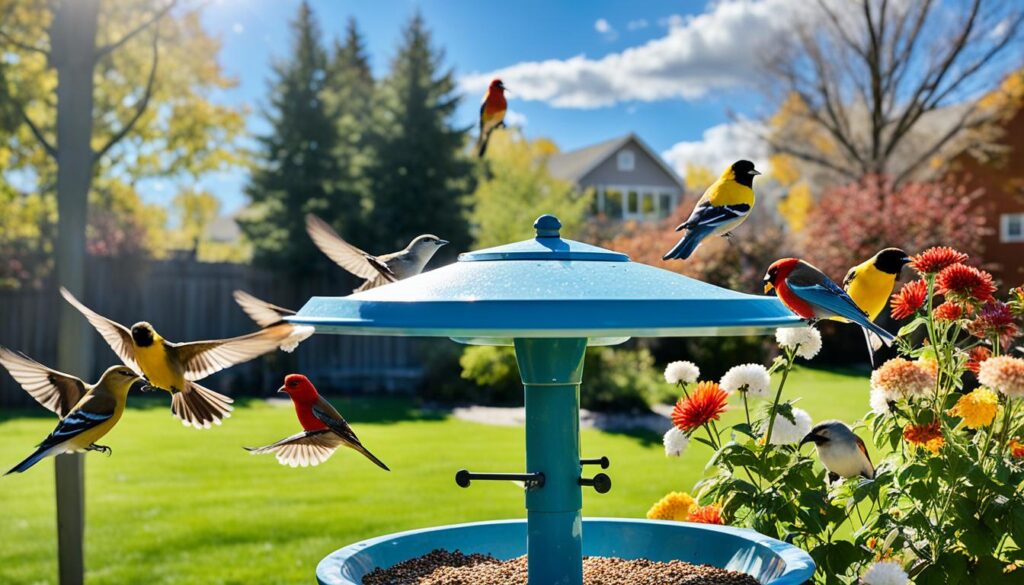
Native Plants for Summer Bird Feeding
When summer comes, think about how you can help local birds in your yard. Bird feeders are great, but native plants are also key for summer bird feeding.
Insect-Friendly Plants for Nesting Birds
Nesting birds need insects for their babies during breeding season. Native plants that attract insects are great for these birds. Some good plants are:
- Milkweed (Asclepias spp.)
- Coneflowers (Echinacea spp.)
- Sunflowers (Helianthus spp.)
- Native wildflowers
These plants draw insects and offer birds places to nest. This makes your yard a better home for birds.
Adding different types of summer plants helps birds stay healthy and happy. It’s good for the birds and makes your yard look better and more natural.
Preparing Feeders for Fall and Winter
As summer ends and the cold comes, it’s important to get your bird feeders ready. Making these changes can turn your backyard into a safe spot for birds all year.
In summer, birds eat less from feeders because they find plenty of food on their own. But in fall and winter, they need our help more. Preparing bird feeders for fall and winter bird feeding is key to helping them survive.
One big thing to think about is seasonal bird feeding changes. When it gets cold, birds need more calories to stay warm and energized. Feeding them black oil sunflower seeds, peanuts, and suet can give them the right food for winter.
- Clean and disinfect your bird feeders to stop diseases from spreading. Use a mix of one part bleach to nine parts water to clean them.
- Check your feeders for damage and fix them to keep them working right.
- Put your feeders in a spot that’s safe from the weather and easy for birds to get to in winter.
- Make sure you have enough bird feeder maintenance stuff like seed, suet, and special foods for your birds.
By getting your bird feeders ready for the seasons, you help the birds in your area. They’ll have a place to get food and stay healthy all year.
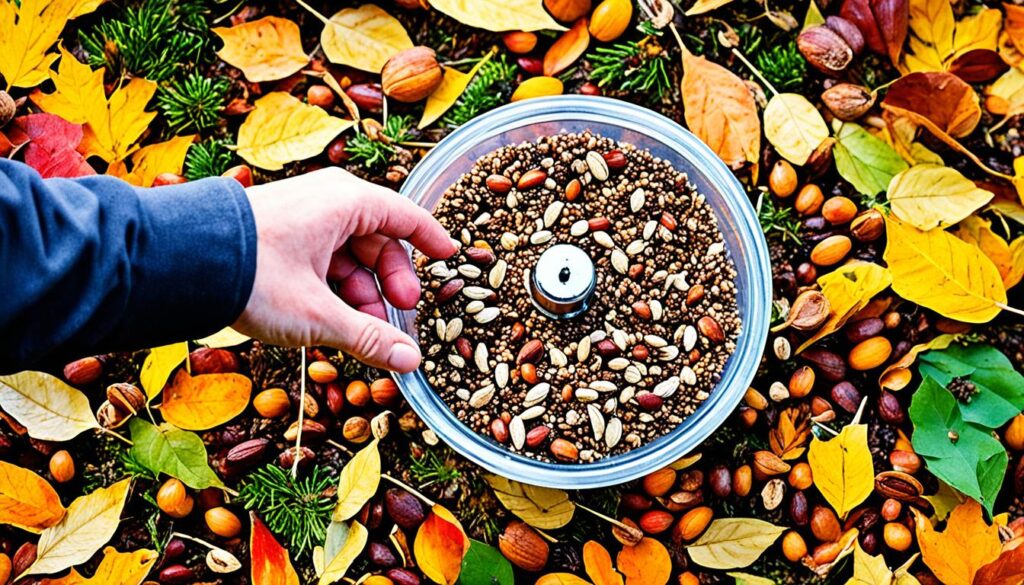
“Food is scarce in winter, and the food you put out in your garden could be the difference between surviving winter and starvation.”
Bird-Friendly Summer Gardening Tips
Summer is a great time to make your garden a haven for birds. You can do this by adding native plants. These plants offer food and places for birds to nest.
Creating a Backyard Bird Sanctuary
Make your garden a bird paradise by using native plants. Add things like:
- Tube feeders for small seed mixes to attract finches, chickadees, and sparrows
- Clean and maintain feeders weekly to prevent mold and disease
- Provide fresh, clean water in birdbaths, changing the water daily to deter mosquitoes
- Install bird houses and nesting platforms to support breeding and nesting activities
- Plant native, insect-friendly flowers and shrubs to support the local food web
These tips will help make your garden a great place for birds. It will support their health and happiness.
“By creating a diverse, natural environment with a variety of native flora, you can support the overall health and well-being of the birds in your backyard and transform your outdoor space into a true avian sanctuary.”
To make a bird sanctuary, think big. Offer different resources for your local birds. With some effort, you can have a beautiful garden that delights you and your feathered friends all summer.
Local Summer Bird Watching Opportunities
As summer comes, your backyard turns into a lively spot for birds. Watching the birds at your backyard birdwatching feeders is fun. Local local birding parks, nature preserves, and wildlife refuges are great for seeing many seasonal bird populations.
Summer bird watching is a great hobby. It lets you learn about the birds in your area. You’ll hear the Blue Jays singing and see American Goldfinches flying around.
“Birdwatching is the greatest sport on earth, because you can pursue it without ever ruffling a feather.” – Jonathan Franzen
You might see Northern Cardinals or Carolina Wrens at your feeders. The joy of summer bird watching is connecting with nature.

So, take your binoculars and visit local parks or nature reserves. Summer is full of local birding chances. You might see some birds you’ve never seen before!
Conclusion
Feeding birds all year, including summer, helps them get extra nutrition. It also supports their health and well-being. Experts say it’s good to keep feeding them different types of seeds and suet.
When you place feeders right and manage food and conflicts with wildlife, your summer bird feeding helps the local bird population. Adding native plants and water sources makes your backyard even better for birds.
A year-round bird care plan that changes with the seasons can really help your local birds. It makes your backyard a healthier place for them.
FAQ
When should I stop feeding birds in the summer?
Experts suggest keeping bird feeders out all year, including summer. This helps birds get the nutrition they need during breeding and nesting. There’s no need to stop feeding birds just because there’s plenty of natural food around.
What should I consider when feeding birds in the summer?
Feeding birds in summer requires some extra care. Suet can spoil or become bad in the heat, so take down suet feeders. Bird seed also goes bad quickly, so change your food often or use less. If you live where bears are common, remove your feeders in summer to avoid problems.
Should I continue feeding hummingbirds and goldfinches in the summer?
Yes, summer is a great time to feed hummingbirds and goldfinches. Hummingbirds need a lot of nectar, so having a steady food supply helps them, especially when they’re raising young. Offering nyjer seed is also good for goldfinches, which nest later in the season.
How can I prevent window collisions during the summer?
To stop birds from hitting windows, place feeders far from windows or close to them. You can also make windows look different with streamers or decals to help birds avoid them.
Does summer bird feeding disrupt migration patterns?
Feeding birds can mess with their migration patterns, so it’s important to feed them but not too much. This helps them use their natural hunting skills.
How can I create a bird-friendly summer garden?
Add native plants to your garden for birds to eat and nest in. This makes your yard a better place for birds and helps them stay healthy. With the right plants, you can make your garden a haven for birds.
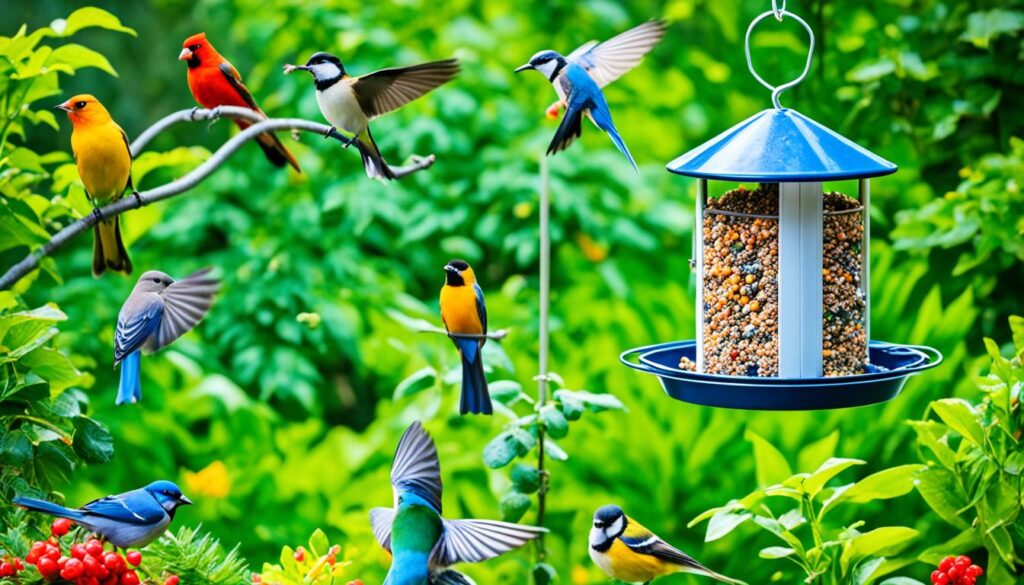

маркетплейс аккаунтов платформа для покупки аккаунтов
продажа аккаунтов биржа аккаунтов
купить аккаунт гарантия при продаже аккаунтов
магазин аккаунтов покупка аккаунтов
аккаунт для рекламы маркетплейс аккаунтов
платформа для покупки аккаунтов маркетплейс аккаунтов соцсетей
услуги по продаже аккаунтов маркетплейс аккаунтов соцсетей
Account market Account marketplace
Account Buying Service https://accountsmarketplacepro.com/
Account Store Account Exchange Service
Accounts marketplace Accounts marketplace
Account Buying Service Account Buying Platform
Account Store Website for Buying Accounts
Profitable Account Sales Sell Account
Buy accounts Profitable Account Sales
Buy and Sell Accounts Account Market
Account Trading Service Account Exchange Service
account trading platform account store
account trading platform account trading platform
account selling platform account trading service
account marketplace buy account
buy accounts account sale
account selling service accounts market
social media account marketplace sell accounts
verified accounts for sale sell pre-made account
account trading service account exchange
account selling platform verified accounts for sale
buy accounts account catalog
verified accounts for sale website for selling accounts
profitable account sales website for selling accounts
accounts for sale account selling platform
website for selling accounts account selling service
account buying service buy account
sell account accounts market
account trading platform account trading platform
account trading platform gaming account marketplace
account trading platform guaranteed accounts
buy accounts accounts marketplace
buy accounts accounts-market-soc.org
account buying service account catalog
database of accounts for sale accounts market
buy and sell accounts online account store
sell account account sale
buy account account store
find accounts for sale account store
find accounts for sale https://accounts-offer.org
database of accounts for sale https://accounts-marketplace.xyz
account selling platform https://buy-best-accounts.org/
guaranteed accounts https://social-accounts-marketplaces.live/
account selling platform accounts-marketplace.live
account store account market
account trading platform https://buy-accounts.space
account marketplace https://buy-accounts-shop.pro
marketplace for ready-made accounts https://buy-accounts.live
online account store https://accounts-marketplace.online/
find accounts for sale buy accounts
продажа аккаунтов https://akkaunty-na-prodazhu.pro/
маркетплейс аккаунтов соцсетей rynok-akkauntov.top
площадка для продажи аккаунтов https://kupit-akkaunt.xyz/
площадка для продажи аккаунтов https://akkaunt-magazin.online
маркетплейс аккаунтов https://akkaunty-market.live/
маркетплейс аккаунтов соцсетей https://kupit-akkaunty-market.xyz/
маркетплейс аккаунтов магазины аккаунтов
магазин аккаунтов https://online-akkaunty-magazin.xyz
маркетплейс аккаунтов соцсетей https://akkaunty-dlya-prodazhi.pro
продажа аккаунтов https://kupit-akkaunt.online
facebook ad account for sale https://buy-adsaccounts.work/
buy facebook old accounts buy facebook account
facebook account sale buy facebook ad account
facebook accounts for sale https://buy-ads-account.click
buy facebook accounts for advertising https://ad-account-buy.top
buy facebook ads account buy facebook ad accounts
buy facebook advertising accounts facebook ads accounts
buy facebook ad account https://buy-ad-account.click
cheap facebook accounts facebook accounts to buy
buy old google ads account sell google ads account
google ads account for sale buy google ads account
buy facebook profiles cheap facebook accounts
buy google ads account https://ads-account-for-sale.top/
buy verified google ads accounts https://ads-account-buy.work
buy google ads agency account buy google ads accounts
google ads accounts adwords account for sale
buy google ad account google ads accounts for sale